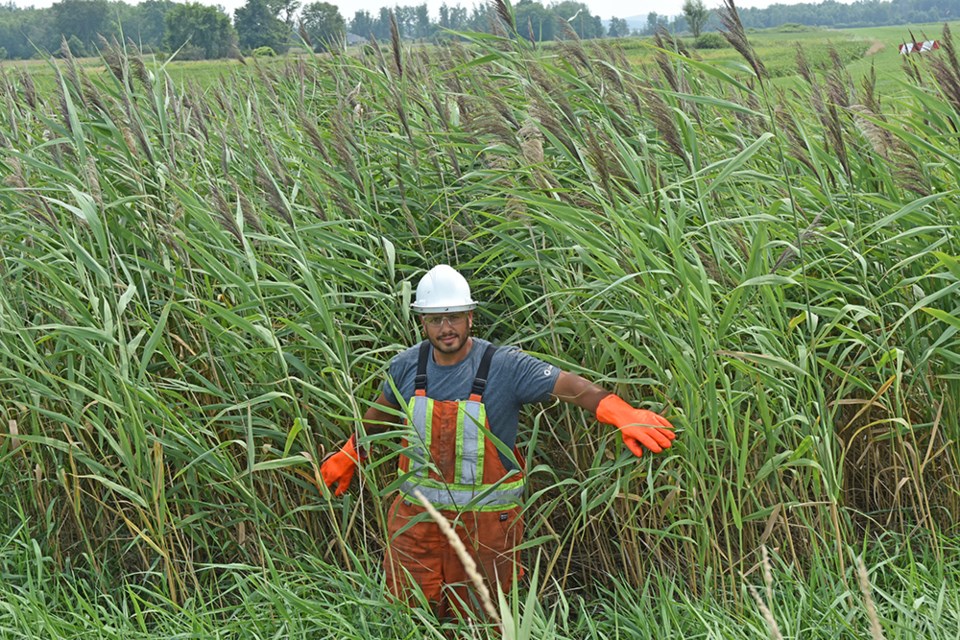Ontario’s environment is under attack, by wave after wave of invaders – from purple loosestrife, to Phragmites australis, zebra and quagga mussels, to the spiny water flea.
The province has identified 440 invasive plant species, both on land and in the water, 39 invasive insect pests and 10 introduced tree diseases.
Not every non-native species brought into the province becomes invasive. It’s only when the species aggressively expands its territory and poses a threat to native plant or animal life, unchecked by natural predation, that it is classified invasive.
And now there are efforts to fight back.
This week saw two initiatives targeting one of the most troublesome invaders – Phragmites australis, the common reed. This aggressive plant is an invader of wetlands and ditches, forming dense stands that not only choke out native species, but conduct chemical warfare against native plants, secreting phytotoxins through their rooting system that suppresses the growth of other species.
Growing up to five metres in height, Phragmites creates sight line issues along roads and waterways, interferes with drainage in ditches, and creates a fire hazard – and now the Town of Innisfil and County of Simcoe have partnered to attack Phragmites on municipal lands, along roadsides.
Innisfil carried out GPS mapping of Phragmites last year, identifying more than 300 sites visible from the road – ranging from one or two plants, to dense stands. Starting on Aug. 14, Robin Egan, Division Manager with Green Stream lawn and vegetation management, began spraying the stands with an herbicide.
The project has special permission from the federal Ministry of the Environment to apply the herbicide, noted Jeremy Nyenhuis with the Town of Innisfil. “It’s at the discretion of the contractor, as to how much he can and can’t treat.”
There is no spraying in areas with standing water, or on residential properties. In residential areas near Lake Simcoe, warning signage will be posted before the spraying is done on Friday.
Egan was out with his sprayer truck, on Tuesday and Wednesday, using the boom arm to spray some roadside stands; in other areas, using a hand-sprayer for greater precision. He’s no novice at Phragmites control. Green Stream has partnered with Bruce Power and other agencies in control efforts, building specialized equipment for a pilot project at the significant wetland at Long Point, where permission has been granted to use herbicides already approved in the U.S., but still awaiting approval in Canada.
Green Stream has also been involved in Phragmites control along the 400-series highways. “We did all of the 402 last year, the 401 between Kitchener and London, the 403,” Egan said. “It’s a huge battle.”
Phragmites is just now beginning to flower and set seed, its dark seed plumes blowing in the wind – “which is exactly why right now you want to be spraying,” said Nyenhuis. And although there has been some concern over the use of herbicides, he noted, “It needs to be done.” Studies have found that, on land, only herbicides and repeated cutting have proven to be effective in halting the spread of the plant.
The Innisfil project is expected to be completed within the week. The immediate effect, said Nyenhuis, should be browning of the stands of Phragmites. “You should see an effect in a couple of days.”
In the spring, the stands will be re-assessed, and the town may undertake cutting as well.
Nyenhuis acknowledged there are limitations to the current project. The spraying can’t extend onto any private lands – which means that where Phragmites has spread onto private property, it is up to the individual landowner to deal with it.
Farmers can get permission to use herbicides, but residential owners are banned from spraying. Their only option is to cut the plants, taking care not to disturb the roots – which would stimulate root growth and spread Phragmites. Residents are advised to cut late in the summer, in July and August, carefully bagging any flowering heads in black plastic bags, then leaving the bagged plants to “cook” in sunlight for a week, before disposal at landfill.
Restricting the spraying to municipal right-of-ways reduces the ability of the project to control Phragmites, agreed Nyenhuis, but at least “we’re trying to be proactive in slowing it down.”
There’s another initiative this Aug. 18. The Nottawasaga Valley Conservation Authority is partnering with groups that include Georgian Bay Forever, the Town of Collingwood, Blue Mountain Watershed Trust, the Ontario Federation of Anglers and Hunters, local condominium associations and community volunteers to Fight the Phrag!
The effort will tackle Phragmites along the Collingwood shoreline, cutting the plants below the waterline, which effectively “drowns” the reeds. Volunteers will help pull cut plant material from the water, for safe disposal.
Morning and afternoon sessions are planned. Volunteers will need to bring sunscreen, a hat, drinking water, clothes that can get wet, sturdy footwear – and be willing to battle invasive Phragmites.
For information contact Vicky Boyd, Phragmites Removal Co-ordinator at 705-424-1479 ex. 246 or [email protected]; register at fight-the-phrag-2018.eventbrite.com.
As for the other 443 invasive plants, the Ministry of Natural Resources and Forestry is struggling to get a handle on their distribution, and impact on Ontario’s environment– and to engage the public.
The MNRF has partnered with the Ontario Federation of Anglers and Hunters and the Invasive Species Centre to track and monitor invasive species in the province. Residents are asked to report sightings of invasive species to the Invading Species Hotline, 1-800-563-7711, or the Early Detection Distribution and Mapping System, www.eddmaps.org/ontario.

